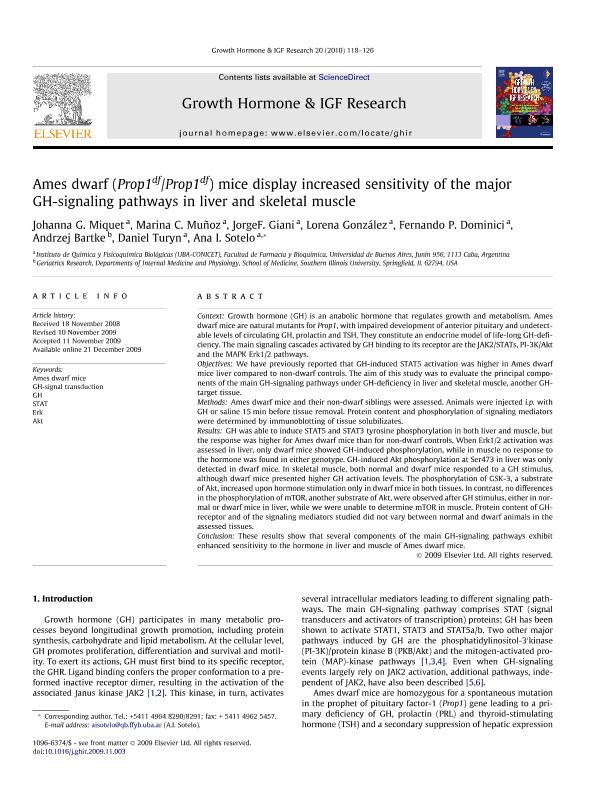Artículo
Ames dwarf (Prop1df/Prop1df) mice display increased sensitivity of the major GH-signaling pathways in liver and skeletal muscle
Miquet, Johanna Gabriela ; Muñoz, Marina Cecilia
; Muñoz, Marina Cecilia ; Giani, Jorge Fernando
; Giani, Jorge Fernando ; Gonzalez, Lorena
; Gonzalez, Lorena ; Dominici, Fernando Pablo
; Dominici, Fernando Pablo ; Bartke, Andrzej; Turyn, Daniel
; Bartke, Andrzej; Turyn, Daniel ; Sotelo, Ana Isabel
; Sotelo, Ana Isabel
 ; Muñoz, Marina Cecilia
; Muñoz, Marina Cecilia ; Giani, Jorge Fernando
; Giani, Jorge Fernando ; Gonzalez, Lorena
; Gonzalez, Lorena ; Dominici, Fernando Pablo
; Dominici, Fernando Pablo ; Bartke, Andrzej; Turyn, Daniel
; Bartke, Andrzej; Turyn, Daniel ; Sotelo, Ana Isabel
; Sotelo, Ana Isabel
Fecha de publicación:
04/2010
Editorial:
Elsevier
Revista:
Growth Hormone
ISSN:
1096-6374
Idioma:
Inglés
Tipo de recurso:
Artículo publicado
Clasificación temática:
Resumen
CONTEXT: Growth hormone (GH) is an anabolic hormone that regulates growth and metabolism. Ames dwarf mice are natural mutants for Prop1, with impaired development of anterior pituitary and undetectable levels of circulating GH, prolactin and TSH. They constitute an endocrine model of life-long GH-deficiency. The main signaling cascades activated by GH binding to its receptor are the JAK2/STATs, PI-3K/Akt and the MAPK Erk1/2 pathways. OBJECTIVES: We have previously reported that GH-induced STAT5 activation was higher in Ames dwarf mice liver compared to non-dwarf controls. The aim of this study was to evaluate the principal components of the main GH-signaling pathways under GH-deficiency in liver and skeletal muscle, another GH-target tissue. METHODS: Ames dwarf mice and their non-dwarf siblings were assessed. Animals were injected i.p. with GH or saline 15min before tissue removal. Protein content and phosphorylation of signaling mediators were determined by immunoblotting of tissue solubilizates. RESULTS: GH was able to induce STAT5 and STAT3 tyrosine phosphorylation in both liver and muscle, but the response was higher for Ames dwarf mice than for non-dwarf controls. When Erk1/2 activation was assessed in liver, only dwarf mice showed GH-induced phosphorylation, while in muscle no response to the hormone was found in either genotype. GH-induced Akt phosphorylation at Ser473 in liver was only detected in dwarf mice. In skeletal muscle, both normal and dwarf mice responded to a GH stimulus, although dwarf mice presented higher GH activation levels. The phosphorylation of GSK-3, a substrate of Akt, increased upon hormone stimulation only in dwarf mice in both tissues. In contrast, no differences in the phosphorylation of mTOR, another substrate of Akt, were observed after GH stimulus, either in normal or dwarf mice in liver, while we were unable to determine mTOR in muscle. Protein content of GH-receptor and of the signaling mediators studied did not vary between normal and dwarf animals in the assessed tissues. CONCLUSION: These results show that several components of the main GH-signaling pathways exhibit enhanced sensitivity to the hormone in liver and muscle of Ames dwarf mice.
Palabras clave:
Ames Dwarf Mice
,
Gh-Signal Transduction
,
Gh
,
Stat
,
Erk
,
Akt
,
Growth Hormone
Archivos asociados
Licencia
Identificadores
Colecciones
Articulos(IQUIFIB)
Articulos de INST.DE QUIMICA Y FISICO-QUIMICA BIOLOGICAS "PROF. ALEJANDRO C. PALADINI"
Articulos de INST.DE QUIMICA Y FISICO-QUIMICA BIOLOGICAS "PROF. ALEJANDRO C. PALADINI"
Citación
Miquet, Johanna Gabriela; Muñoz, Marina Cecilia; Giani, Jorge Fernando; Gonzalez, Lorena; Dominici, Fernando Pablo; et al.; Ames dwarf (Prop1df/Prop1df) mice display increased sensitivity of the major GH-signaling pathways in liver and skeletal muscle; Elsevier; Growth Hormone; 20; 2; 4-2010; 118-126
Compartir
Altmétricas



